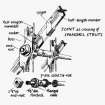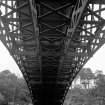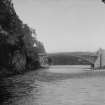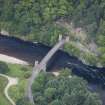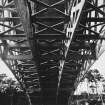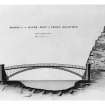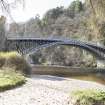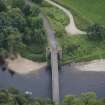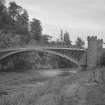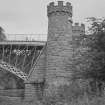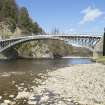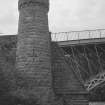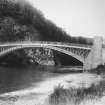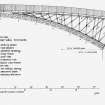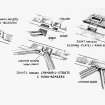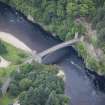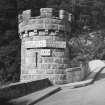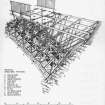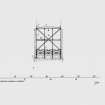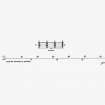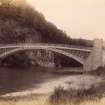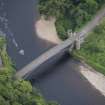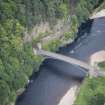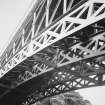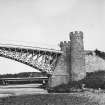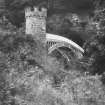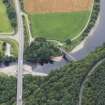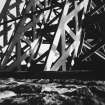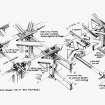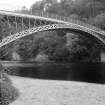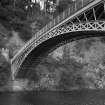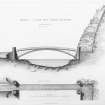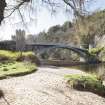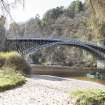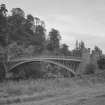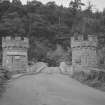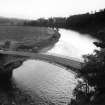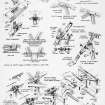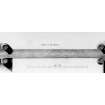Pricing Change
New pricing for orders of material from this site will come into place shortly. Charges for supply of digital images, digitisation on demand, prints and licensing will be altered.
Craigellachie, Telford Bridge
Road Bridge (19th Century)
Site Name Craigellachie, Telford Bridge
Classification Road Bridge (19th Century)
Alternative Name(s) Craigellachie Bridge; Craigellachie Pot; River Spey; Old Bridge
Canmore ID 16336
Site Number NJ24NE 15
NGR NJ 28532 45194
Datum OSGB36 - NGR
Permalink http://canmore.org.uk/site/16336
- Council Moray
- Parish Knockando
- Former Region Grampian
- Former District Moray
- Former County Morayshire
Built between 1812-15, the Craigellachie Bridge spans the River Spey and was designed by engineer Thomas Telford. It is the oldest surviving cast-iron bridge in Scotland and is considered one of the finest of its type in Britain. Castellated stone abutments support four ribs that form the single arch of the bridge, above which the roadway is carried by latticed girders.
Information from RCAHMS (SC) 6 August 2007
NJ24NE 15 28531 45199
Telford Bridge [NAT]
OS 1:10,000 map, 1976.
Telford Bridge [NAT]
OS (GIS) AIB, April 2006.
For successor bridge (adjacent to E), see NJ24NE 26.
NMRS REFERENCE:
Architect: Thomas Telford, 1815.
(Undated) information in NMRS.
(Location cited as NJ 285 452). Craigellachie Bridge. This bridge was built in 1812-15 by engineer Thomas Telford and is one of the finest cast-iron bridges in Britain. A single 150ft (45.7m) arched span, with 4 ribs, is supported by rustic ashlar abutments, with castellated terminals and rubble wing walls. One of the terminals (on the Banff side) has 2 cast-iron plaques with the legends 'CAST AT PLAS KYNASTON RUABON DENBEIGHSHIRE' and '1814'.
J R Hume 1977.
This bridge is the oldest surviving iron bridge in Scotland. It cost 8,200 pounds sterling, which was 200 pounds sterling more than the estimate, and the money was found by the Parliamentary Commissioners and by local subscribers. It was restored in 1964 by Banff, Moray and Nairn County Councils, and by-passed in 1972.
The ironwork was cast at Plas Kynaston by William 'Merlin' Hazledine, Telford's normal ironmaster. It was erected by William Stuttle, Telford's foreman, and the stonework was by John Simpson, mason, of Shrewsbury.
The bridge is situated to take advantage the constriction formed by an outcrop of hard Moinian gneiss. Telford allowed for floods by placing the bridge on abutments 12'(3.7m) above normal water level; it withstood the flood of 1829, when the Spey here rose 15' 6" (4.7m), although the flood arches were washed away.
The four ribs are mounted 15' (4.6m) apart and they make an arc of smaller radius than the roadway, which partly accounts for the lightness of the bridge. The spandrels are formed of diamond lattice which also contributes to the delicacy of the design. The castellated rustic ashlar towers that decorate the abutments are 50' (15.2m) high and hollow with false arrow slits; they are perhaps rather heavy.
G Nelson 1990
This bridge formerly carried the A941 public road over the River Spey between the parishes of Knockando (to the N) and Aberlour (to the S), within the pre-1975 counties of Morayshire and Banffshire respectively. Both these parishes fall within the post-1975 Moray District of Grampian Region.
Information from RCAHMS (RJCM), 7 December 1995.
The location assigned to this record defines the apparent midpoint of the span. The available map evidence suggests that it extends from NJ c. 28523 45224 to NJ c. 28542 45164.
Information from RCAHMS (RJCM), 7 April 2006.
Construction (1 January 1812 - 31 December 1815)
Photographic Survey (1900 - 1930)
Photographs by A Brown & Co of sites across Scotland c1900-1930
Conservation (1 January 1962 - 31 December 1964)
Photographic Record (1962)
Photographs taken prior to conservation work being carried out.
Photographic Survey (1 August 1963 - 31 August 1963)
Photographic Survey (August 1963)
Photographic survey of Craigellachie Bridge, by the Scottish National Buildings Record/Ministry of Work in August 1963.
Publication Account (1986)
'The bridge is of iron, beautifully light, in a situation where the utility of lightness is instantly perceived. The span is 150 feet, the rise 20 from the abutments, which are themselves 12 above the usual level of the stream.' (Robert Southey, ]ournal of a Tour of Scotland in 1819).
Probably the oldest surviving iron blidge in Scotland, and one of the finest in Britain, this is one of Thomas Telford's most spectacular creations. A single fourribbed arch of cast-iron with a span of 45.7m, it leaps the swift Spey, springing from abutments of rustic ashlar topped by cylindrical crenellated turrets.
It was built between 1812 and 1815 as part of the overall improvement of the Highland road system then in progress under the direction of the Commissioners for Roads and Bridges, who put up half the £8200 cost. It was a vital crossing of the Spey, midway between Fochabers and Grantown, where the river is contained by the hard rock of the north bank. (This crag had to be cut back for the approach.)
The Commissioners' engineer, Thomas Telford, built in iron springing from tall abutments in order to accommodate the ferocious rise to which the Spey in flood is prone; the arch survived the devastating flood of 1829. The masonry abutments were the work of Telford's assistant, the Shrewsbury builder John Simpson, while the ironwork was cast at Plas Kynaston in the vale of Llangollen in Denbighshire by William Hazeldine (,Merlin' Hazeldine to Telford). The iron libs then had to be floated over Telford's other extraordinary work, the Pontcysyllte aqueduct on the Llangollen canal and shipped round to the Moray Firth and up the Spey.
Information from ‘Exploring Scotland’s Heritage: Grampian’, (1986).
Publication Account (1986)
Thomas Telford's bridge at Craigellachie, erected in 1814-15 across the River Spey, and its sister bridge built two years earlier across the Dornoch Firth at Bonar, Sutherland, together represent his two major works in Scotland that employed the structural use of cast iron. They were basically identical in design and shared the distinction of being prototypes for his several large arch-bridges subsequently built in Britain. The ironwork for both bridges was cast by William Hazeldine in his foundry at Plas Kynaston in North Wales and was probably erected on site by his foreman William Stuttle. Prior to its reconstruction above the arch-ribs in 1963, the Craigellachie bridge bore the inscription 1814/ CAST AT PLAS KYNASTON/ RUABON DENBIGHSHIRE, cast in bold relief at one end of the parapet skirting.
Built in the form of a segmental arch with a rise of 20 ft 9 in (6.33m), and a width of 15 ft m1 in (4.60m), it spans 151 ft 6in (46.18m) between granite abutments topped with twin turrets and raked at an angle radial with the arch. Its four longitudinal ribs are made up of seven castings, each pierced with latticed subdivisions and bolted together through transverse ribs, also pierced with openings to lessen the weight. For lateral stability the ribs were further stiffened by latticed cross-plates extending over the full width of the arch extrados, and by a series of stout horizontal tie-bars fixed at intervals between .the ribs along their lower edge. Rows of diagonal struts, set within the arch spandrels, provided longitudinal bracing and direct support to the road-bearers, also stiffened transversely by tie-bars fixed to their intersections, and by two pairs of diagonal swaybraces on each side of the crown. In general, the various members were connected by bolted flanges, or by a system of joggle-and-socket Joints cast on the frames and evidently held together simply by iron pins or wedges and the compressive forces acting upon them.
Information from ‘Monuments of Industry: An Illustrated Historical Record’, (1986).
Publication Account (1996)
'The bridge is of iron, beautifully light, in a situation where the utility of lightness is instantly perceived. The span is 150 feet, the rise 20 from the abutments, which are themselves 12 above the usual level of the stream .' (Robert Southey, Journal of a Tour of Scotland in 1819).
Probably the oldest surviving iron bridge in Scotland, and one of the finest in Britain, this is among Thomas Telford 's most spectacular creations. A single four-r ibbed arch of cast- iron with a span of 45.7m, it leaps the swift Spey, springing from abutments of rustic ashlar topped by cylindrical crenellated turrets.
It was built between 1812 and 1815 as part of the overall improvement of the Highland road system then in progress under the direction of the Commissioners for Roads and Bridges, who put up half the £8200 cost. It was a vital crossing of the Spey, midway between Fochabers and Grantown, where the river is contained by the hard rock of the north bank. (This crag had to be cut back for the approach.)
The Commissioners' engineer, Thomas Telford, built in iron springing from tall abutments in order to accommodate the ferocious rise to which the Spey in flood is prone; the arch survived the devastating flood of 1829. The masonry abutments were the work of Telford's assistant, the Shrewsbury builder John Simpson, while the ironwork was cast at Plas Kynaston in the vale of Llangollen in Denbighshire by William Hazeldine ('Merlin' Hazeldine to Telford). The iron ribs then had to be floated over Telford's other extraordinary work, the Pontcysyllte aqueduct on the Llangollen canal and chipped round to the Moray Firth and up the Spey.
Information from ‘Exploring Scotland’s Heritage: Aberdeen and North-East Scotland’, (1996).
Publication Account (2007)
Craigellachie Bridge
This bridge (see front cover), built from 1812–14, incorporates the earliest surviving prefabricated lozenge lattice spandrel cast-iron arch designed by Telford, the first being the main arch of the almost identical Bonar Bridge
(1812–92). At least ten arches of this state-of-the-art genre were erected in Britain as far south as Tewkesbury by 1829. The ironwork was cast at William Hazledine’s foundry at Plas Kynaston, Ruabon, Denbighshire, transported by sea to Speymouth and then by wagon to Craigellachie. The
contractors were John Simpson and John Cargill. The ironwork was erected on pre-erected centring in August and September 1814 under the direction of William Stuttle, Hazledine’s foreman. The bridge was opened two months later.
The bridge spans the Spey with a single arch of 150 ft span and a rise of 20 ft, and three stone arches of 15 ft span on the south-east approach. The iron deck plates of the 1312 ft wide roadway are supported by a series of
braced cruciform struts carried on four lattice arch ribs. These ribs are 2 1/2 in. thick and 3 ft deep, cast in seven sections, each about 23 ft long. The cost of the bridge and its approach roads, from the south-east over the floodplain and from the north via a gallery cut into the cliff overhanging
the river and right-angle bend, was £8200 of which less than half was for the ironwork.
The bridge, with minor modifications, continued in use until 1963–64 when it was reconstructed above the archribs, with significant retention of ironwork and character, by W. W. Lowson, partner of W. A. Fairhurst & Partners, Aberdeen, for Banff, Moray and Nairn Councils. The original cast-iron deck plates were retained. The main items of new, near matching, steelwork, were the side railings and spandrel bracing.
The configuration and lightness of this innovative bridge type to achieve permanent crossings at sites impracticable for founding stone bridges, particularly as here in deep and fast-moving water, demonstrates Telford and Hazledine’s mastery of cast-iron in bridge construction.The bridge was bypassed and closed to vehicles in 1972 when its pre-stressed concrete replacement just downstream, also designed by W. A. Fairhurst, was opened. Craigellachie Bridge is now in the stewardship of Moray
Council as an outstanding historical and scenic amenity used by pedestrians and cyclists.
R Paxton and J Shipway, 2007.
Reproduced from 'Civil Engineering heritage: Scotland - Highlands and Islands' with kind permission from Thomas Telford Publishers.
Publication Account (2007)
In this year in which the 250th anniversary of the birth of Thomas Telford is celebrated and RCAHMS has undertaken the HLF-supported project Telford in the Highlands’, it seemed appropriate to extend the route to visit one of Telford’s finest bridges. Craigellachie was built between 1812 and 1814, and incorporates the earliest surviving pre-fabricated lozenge-lattice spandrel cast-iron design by Telford. It cost £8,200, which was £200 more than the estimate, and the money was found by the Parliamentary Commissioners and by local subscribers. It was restored in 1964 by Banff, Moray and Nairn County Councils.
The ironwork was cast at Plas Kynaston by William ‘Merlin’ Hazledine, Telford’s usual ironmaster, and was erected by William Stuttle, Telford’s foreman. The stonework was by John Simpson, mason, of Shrewsbury.
The bridge is situated to take advantage of the constriction formed by an outcrop of hard Moinian gneiss. Telford allowed for floods by placing the bridge on abutments 12" (3.7m) above normal water level; it withstood the flood of 1829, when the Spey here rose 15’ 6" (4.7m), although the flood arches were washed away.
The four ribs are mounted 15" (4.6 m) apart and they make an arc of smaller radius than the roadway, which partly accounts for the lightness of the bridge. The spandrels are formed of lozenge-lattice cast iron, which also contributes to the delicacy of the design. The castellated rustic ashlar towers that decorate the abutments are 50" (15.2m) high and are hollow with false arrow slits.
This bridge, which was by-passed in 1972, formerly carried the A941 public road over the River Spey between the parishes of Knockando (to the north) and Aberlour (to the south), within the pre-1975 counties of Moray and Banffshire respectively. RCAHMS’ extensive collections on the bridge include drawings and photographs from the nineteenth centuries and twentieth centuries. It was recorded by RCAHMS in 1980, and detailed drawings of its structure were made by Geoffrey Hay and were published in Monuments of Industry.
Information from ‘Commissioners’ Field Meeting 2007'.
Photographic Survey (1 May 2013)
Photographed on behalf of the Buildings of Scotland publications 2013-14.


























































